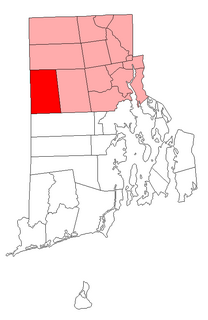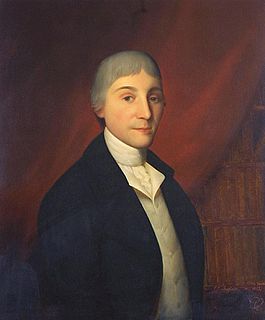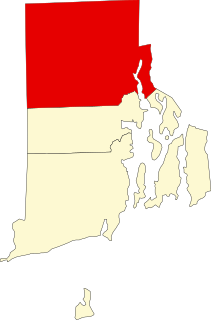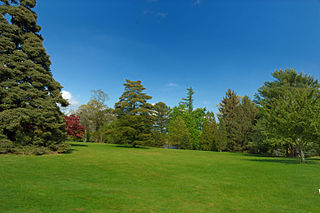
Bayard Cutting Arboretum State Park is a 691-acre (2.80 km2) state park located in the hamlet of Great River, New York, on Long Island. The park includes an arboretum designed by Frederick Law Olmsted for William Bayard Cutting in 1886, as well as a mansion designed by Charles C. Haight. Cutting purchased the property in 1881.

Theodore Foster was an American lawyer and politician from Rhode Island. He was a member of the Federalist Party and later the National Republican Party. He served as one of the first two United States Senators from Rhode Island and, following John Langdon, served as dean of the Senate.

Wakefield is a village in the town of South Kingstown, Rhode Island, and the commercial center of the town. Together with the village of Peace Dale, it is treated by the U.S. Census as a component of the census-designated place identified as Wakefield-Peacedale, Rhode Island. West Kingston, another South Kingstown village, was the traditional county seat of Washington County. Since 1991, the Washington County Courthouse has been in Wakefield. The Sheriff's Office which handles corrections is also in Wakefield.

Saunderstown is a small village and historic district in the towns of Narragansett and North Kingstown in Washington County, Rhode Island, United States.

Casey Farm is a historic farm in Saunderstown, Rhode Island, United States. It is now a historic museum property, operated by Historic New England, and is open to the public.

The 'Rhode Island Greening' is an old, historic American apple variety and the official fruit of the state of Rhode Island.

Oxon Cove Park and Oxon Cove Farm is a national historic district that includes a living farm museum operated by the National Park Service, and located at Oxon Hill, Prince George's County, Maryland. It is part of National Capital Parks-East. It was listed on the National Register of Historic Places in 2003.

The Alfred Drowne Road Historic District of Barrington, Rhode Island, encompasses a suburban area developed between about 1860 and 1910, a period of significant suburban growth in Barrington spurred by the connection of the town by rail to Providence in 1855. This 27-acre (11 ha) residential area was before that time farmland owned by Alfred Drown, whose c. 1830 farmhouse still stands at 13 Alfred Drowne Road. The house of his son Benjamin, built c. 1856, is at number 27. The district includes properties along Alfred Drowne Road, as well as a few properties on Washington Street and Annawamscutt Road which are immediately adjacent.
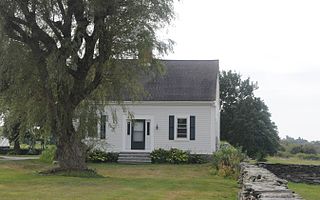
The Bailey Farm is an historic farm at 373 Wyatt Road in Middletown, Rhode Island. Now reduced from more than 100 acres (40 ha) to about 45 acres (18 ha), the farm is a well-preserved example of a 19th-century island farm. It was owned by members of the Bailey family, possibly as early as the late 17th century, into the 19th century. The original main house appears to be a mid-18th century structure that was given a significant Greek Revival treatment in the 19th century. It is a 1-1/2 story Cape style house, three bays wide, with a central chimney. The main entrance is centered on the northern facade, and is flanked by sidelight windows and pilasters, with an entablature above. The corners of the building are pilastered. A series of outbuildings stand nearby. There is a second complex of buildings on the northwest part of the property, built in the 1930s near the location of the Bailey family cemetery.
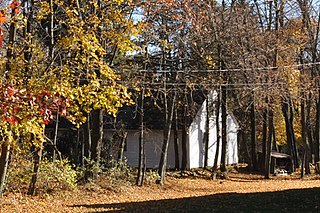
The John Cole Farm is an historic colonial farm on Reservoir Road in the far northeast of Cumberland, Rhode Island. The main farmhouse, a 1-1/2 story Cape style wood-frame structure, was built c. 1770 by John Cole not long after his acquisition of the property. The property, including a half-dozen outbuildings, has had only minimal intrusion of modern 20th-century amenities, and is a well-kept example of vernacular rural architecture of the late 18th century.
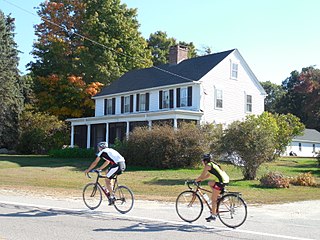
The Mathewson Farm is an historic farm on 544 Greenville Avenue in Johnston, Rhode Island. It is an agricultural remnant of the formerly rural village of Belknap. The centerpiece of the farm complex is a late 18th-century farmhouse with vernacular Federal styling. Surviving outbuildings of the farm include a barn from the early 20th century, a henhouse, and a silo. This property was developed as a farm by William Mathewson in the 1790s, and was actively farmed by his descendants until the 1940s.
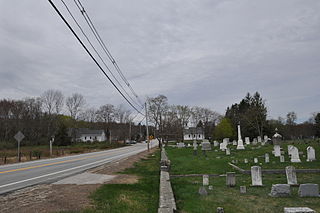
The Moosup Valley Historic District is a rural, agricultural historic district in western Foster, Rhode Island. The focal center of the area is a small village where Moosup Valley Road crosses the Moosup River, and where the Moosup Valley Christian Church is located. The largest concentration of buildings in the district lie along a roughly one-mile stretch of Moosup Valley Road west of Rhode Island Route 14, with properties extending along some of the winding roads that extend from that road. The district encompasses most of the headwaters of the Moosup River. The major public buildings are the church, a vernacular Greek Revival structure built in 1864-65, and the Grange hall, built in 1926. There is also a one-room schoolhouse which was built in 1811, and later used as a library and community center.

The Winsor–Swan–Whitman Farm is an historic house at 416 Eaton Street in Providence, Rhode Island. The farmhouse was built in 1742 and added to the National Register of Historic Places in 1974.
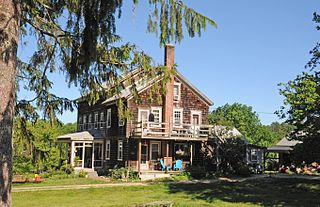
The Austin Farm Road Agricultural Area is a rural historic district in Exeter, Rhode Island. The district is bounded on the east by Interstate 95, on the north by the town line, on the south by Austin Farm Road, and on the west by a north-south line through Austin Farm Pond. This agricultural area is relatively little altered since the late 19th century, despite the proximity of the interstate. It includes the farm complex built up by John Austin in the 19th century, which continues to see active use, and the site of an older farm complex, reduced to just the farmhouse, which predates Austin's acquisition of the property. In addition to the farm buildings, it includes a chapel and school house built or maintained by Austin.
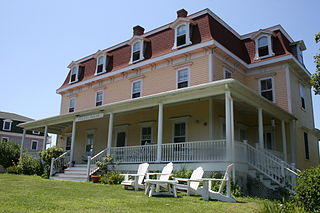
Hygeia House is a historic vacation home on Beach Avenue on Block Island.
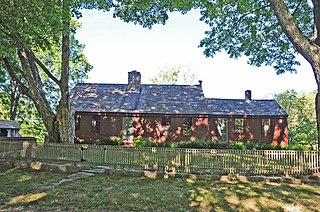
The Simon Lillibridge Farm is an historic farm property at 75 Summit Road in Exeter, Rhode Island. The 38-acre (15 ha) property is all that remains of an original 200-acre (81 ha) parcel purchased by Simon Lillibridge in the 1810s. The main house, a two-story wood frame structure, was either built by Lillibridge, or was already on the property when he bought it. Architectural analysis of the house suggests that at least portions of it were built in the 18th century, with hand-hewn beams, and other stylistic elements suggesting construction during the Georgian period. The farm complex includes other 19th-century buildings, including a barn, shed, wagon shed, and outhouse, as well as a family cemetery. The property was in regular agricultural use until about 1935, and was used thereafter as a summer residence.

Green’s End is a historic village and populated area in Middletown, Rhode Island. Witherbee School (1900) is located in the area.
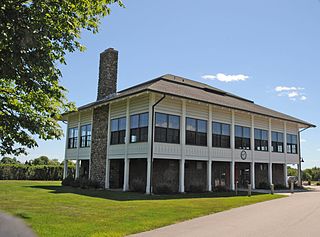
The Anthony–Kinney Farm is an historic farm and resort complex at 505 Point Judith Road in Narragansett, Rhode Island. The property, now a town-owned recreation area known as Sunset Farm, saw agricultural use for over 300 years, and was converted into a private resort around the turn of the 20th century. The Point Judith area was among the first in Rhode Island to be purchased from the local Narragansett people, in 1657. The farm was acquired by James E. Anthony in 1850, who sold it to Francis Kinney in 1897. Kinney maintained much of the land in agricultural use, but built an extravagant resort complex, including a distinctive East Indian bungalow as a clubhouse, and built a private nine-hole golf course. Kinney died in 1908, and the property was owned by the Chase family until 1991, when most of it was purchased by the town. It is managed by the town as an active farm, and the restored clubhouse is available for rent as function space.
